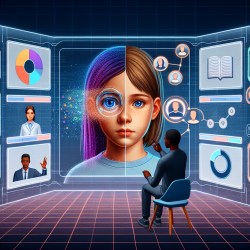How to Supercharge Your Online Therapy Skills with Cutting-Edge Eye Tracking Research!

Eye tracking technology is transforming the landscape of online therapy, providing new insights and tools to enhance therapeutic outcomes. TinyEYE, a leader in online therapy services for schools, can leverage the latest findings from eye tracking research to improve the quality of care. Let's dive into the key takeaways from the retracted article, "Eye tracking: empirical foundations for a minimal reporting guideline," and explore how these insights can elevate your therapy skills.
Understanding Eye Tracking and Its Relevance
Eye tracking involves measuring where and how long a person looks at various stimuli. This technology has applications across multiple fields, including special education and therapy. By analyzing eye movements, therapists can gain insights into a client's attention, cognitive load, and emotional state.
Key Findings from the Research
The retracted article provides an empirical foundation for reporting guidelines in eye tracking studies. Here are some crucial takeaways that can be applied to online therapy:
- Data Quality Matters: The quality of eye-tracking data—accuracy, precision, and data loss—significantly impacts the validity of the findings. Ensure your eye-tracking setup is calibrated correctly and that you understand the limitations of your equipment.
- Environment and Setup: The recording environment and setup, including lighting conditions and participant positioning, can affect data quality. Consistent, controlled environments yield the best results.
- Participant Characteristics: Factors such as age, visual acuity, and even the use of visual aids can influence eye-tracking data. Be mindful of these variables when interpreting results.
- Calibration and Validation: Proper calibration and validation procedures are essential for accurate data. Regularly recalibrate your equipment to maintain data integrity.
- Event Detection Algorithms: The choice of algorithms for detecting fixations and saccades can affect the analysis. Use algorithms that are robust to noise and data loss for more reliable results.
Implementing Eye Tracking in Online Therapy
Here’s how you can integrate these findings into your practice to enhance therapy sessions:
- Personalize Interventions: Use eye tracking to monitor how clients engage with digital content. Tailor interventions based on their attention patterns and areas of interest.
- Monitor Progress: Track changes in eye movement patterns over time to assess progress and adjust therapy plans accordingly.
- Enhance Engagement: Identify which types of content or activities capture the client's attention the most and incorporate more of these elements into your sessions.
- Reduce Cognitive Load: Use eye tracking to identify tasks or activities that may be overwhelming for clients and modify them to reduce cognitive load.
Encouraging Further Research
While the retracted article provides a solid foundation, it's crucial to stay updated with ongoing research in eye tracking. Encourage your team to engage with the latest studies and consider participating in research projects to contribute to the field.
Conclusion
Eye tracking technology offers a powerful tool for enhancing online therapy. By understanding and implementing the findings from eye tracking research, you can improve the quality of your sessions and better support your clients. To read the original research paper, please follow this link:
RETRACTED ARTICLE: Eye tracking: empirical foundations for a minimal reporting guideline.
Citation: Holmqvist, K., Örbom, S. L., Hooge, I. T. C., Niehorster, D. C., Alexander, R. G., Andersson, R., Benjamins, J. S., Blignaut, P., Brouwer, A.-M., Chuang, L. L., Dalrymple, K. A., Drieghe, D., Dunn, M. J., Ettinger, U., Fiedler, S., Foulsham, T., van der Geest, J. N., Hansen, D. W., Hutton, S. B., Kasneci, E., Kingstone, A., Knox, P. C., Kok, E. M., Lee, H., Lee, J. Y., Leppänen, J. M., Macknik, S., Majaranta, P., Martinez-Conde, S., Nuthmann, A., Nyström, M., Orquin, J. L., Otero-Millan, J., Park, S. Y., Popelka, S., Proudlock, F., Renkewitz, F., Roorda, A., Schulte-Mecklenbeck, M., Sharif, B., Shic, F., Shovman, M., Thomas, M. G., Venrooij, W., Zemblys, R., & Hessels, R. S. (2022). RETRACTED ARTICLE: Eye tracking: empirical foundations for a minimal reporting guideline. Behavior Research Methods, 55(1), 364-416. https://doi.org/10.3758/s13428-021-01762-8










